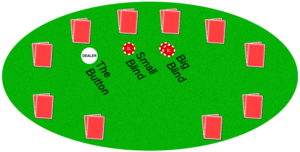I figured I would put together a simple system to playing a poker tournament. Use this as a "base;" that is, the system you will adjust as you learn more from your game.
Round 1: Try to get a read on your opponents.
Are there players who are loose and aggressive? If so, you are going to figure out how to try to isolate yourself against this player.
Are there players who are tight and passive? Ideally, you want these players to your left so you steal their blinds.
This doesn't stop after the first round as you always want to get a read on your opponents.
Early Rounds: Accumulate chips
Don't play tight. Play to accumulate chips. You want to open up your game and figure out how to play against your opponents playing styles.
If you are in an early position (1st 3 positions to the right of the big blind):
Small or medium pair just limp. If you get raised, be willing to put in 10% of your stack to see the flop. No set on flop, no bet. If you hit your set, just check or raise 2x's your opponent's bet on the flop.
 Image via Wikipedia
Image via Wikipedia
If you get a premium pair QQ, KK, AA or AK or AQ, raise 3x's the big blind. If you get re-raised, just move all-in. If you have a cooler so be it. If you get pocket 9's, 10's, or Jacks, just raise 2.5x's the big blind. If you get re-raised, you are willing to call 10% of your stack. If the re-raise is from a player who is loose-aggressive, just move all-in.
If you get a trouble hand in early position, you know those J-10, Q-10, K-J, K-Q type hands, just put in a min raise. Don't fold. You want to steal the blinds. If you get raised, only call with the suited trouble hands and it doesn't cost you more than 10% of your stack. If you miss, fold. If you hit, play against your opponent's bet size and your image of his play. Assume a small bet, means he misses and a 3/4th to pot size bet means he may have you beat. The small bet, raise the action. The pot sized bet you want to call and see the turn. It depends on your image of your opponent, on what happens on the turn. Few players can fire a second bullet.
In middle position, the pocket 9's, 10's, and J's, you should put in a 3x big blind pre-flop raise. If someone raises before you, you should call to see the flop if it only costs you 10% of your stack.
In middle position, those trouble hands are played the same way, except you don't want to call a raise unless it is a suited trouble hand and only costs you 10% of your stack.
Late Positions=Attack Positions
In late position, everything is the same except that you are going to attack players from the cutoff, button and small blind with any 2 cards when you are first in the hand if you know these players are tight, and even better if they are tight and passive. First in preflop: from the cut-off and button, put in a 3x's big blind raise. In the small blind, put in a 4x big blind raise. If you get re-raised, you will have to fold.
Middle to Late Rounds
In the middle to late rounds, you are no longer going to limp with small and medium pairs in early position. A min raise is fine. You will no longer limp into the pot when the game gets to the middle to late rounds.
Calling a pre-flop raise should only be done if you need chips, you have pocket Kings or Aces, someone has raised before you, and you can double up through that player.
Calling a pre-flop raise can also be done with any pair. Try to hit it big with a set.
Additional Guidelines:
Small blind play: call those 1/2 bets with any 2 suited cards and playable hands.
Big blind play: If you have almost any playable hand and you are getting 2-1 or better, call the raise to see the flop.
If a player raises in early position, give that raise respect.
If a player raises in middle position, give that raise less respect. If the player is loose with his opening hands, put in a re-raise.
If a player raises in late position, look to re-raise with a good to premium hand unless that player is very tight.
You are going to move all-in when you are 8 times or less the big blind in early position with A-J or better. You can adjust the strength of your hand downward as you are in a later position and first in the pot.
If you get to 5 times or less the big blind, look to play any Ace, King, or Queen hand, any pair, suited connectors, and any 2 cards that when added together equal a 19 or better.
Next Step
At the end of the tournament, figure out what worked and what didn't work and adjust your game accordingly. Write down notes and guidelines for your next event. Again, based on your results of that event, see how you can adjust the strategy to make your plan better.
Make sure you write down your learning and what is being changed, so you can finally uncover a poker system that works for your style.
![Reblog this post [with Zemanta]](http://img.zemanta.com/reblog_e.png?x-id=b78d2b02-edd8-4692-a2aa-d5e68d135c0f)








1 comment:
Was on a very annoying cooler because I was betting out too much inteh early rounds. This guide put me back on track and I cashed in the next SNG I played.
Post a Comment